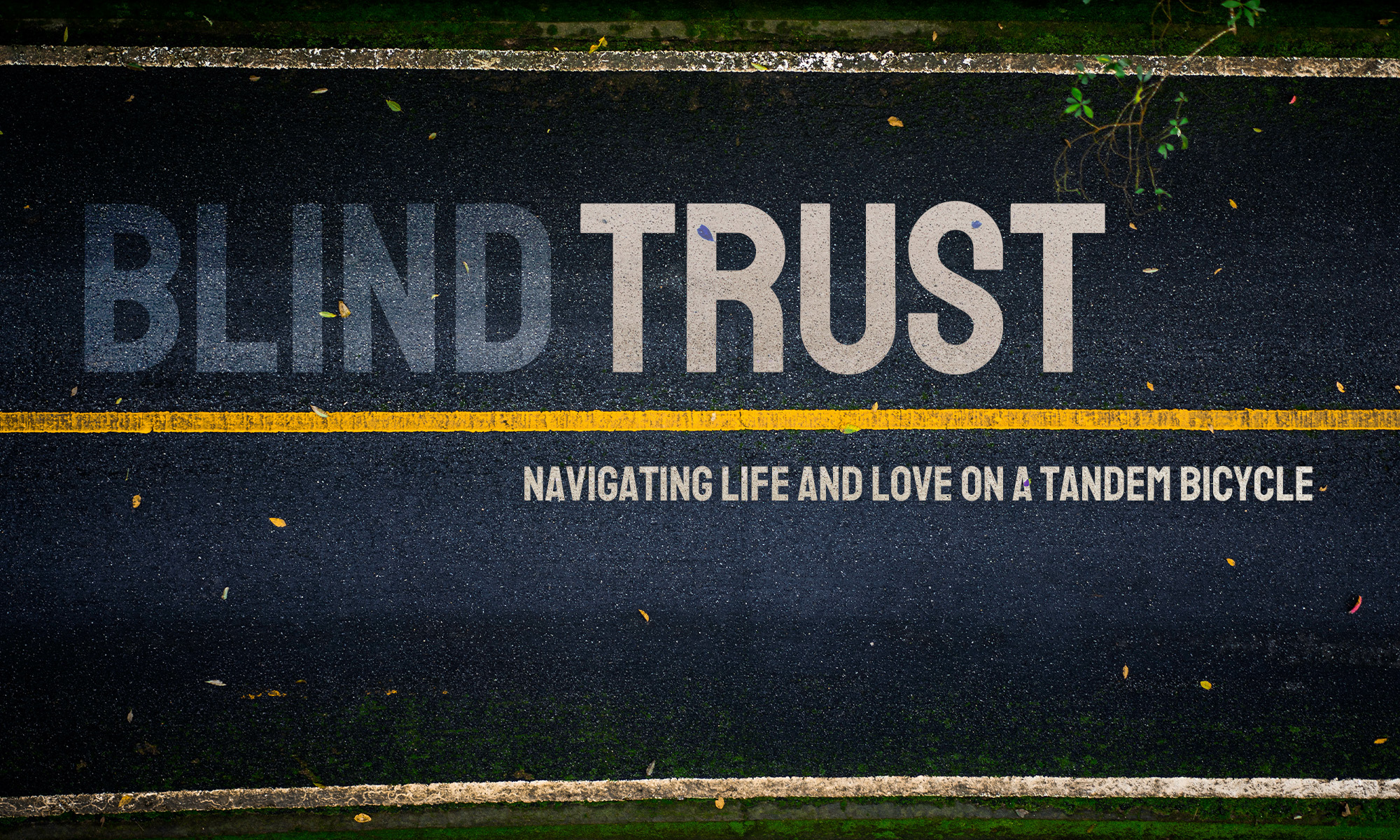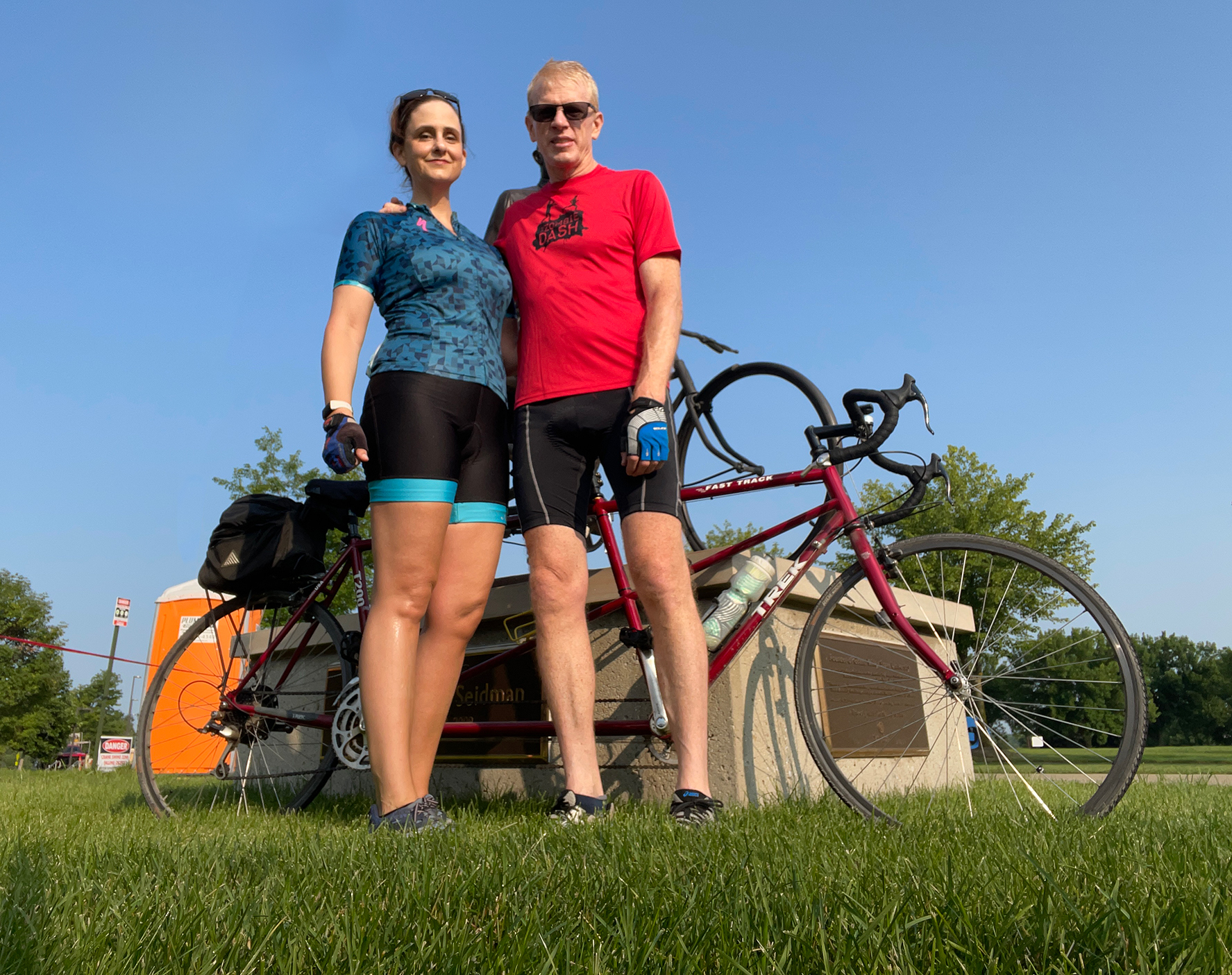Digital Composition: Mike Rendel
Story by: Jill Hinton Wolf
The phrase “Tandemonium!” has become a sort of code word between my husband and I. Whenever we see a tandem bicycle as we’re driving around town or even when we’re riding our own tandem past other “twocycles,” as my daughter called them, we shout it out. It’s an inside joke we share, though I realize it comes off as a bit goofy to those who happen to be around us when it happens.
Mike and I were gifted our first tandem bicycle in the fall of 2018, two years after I was unexpectedly diagnosed with retinitis pigmentosa (RP). RP is a rare genetic disease that essentially causes a breakdown of the cells in my retinas. As a side effect of the RP, I also struggle with cystic macular edema (CME) or “bubbles” in my central vision, which I manage via steroid injections into my eyes every 12 weeks.
Essentially, the cells in my retinas are slowly flickering off, from the peripheral in, while my central vision often feels like viewing the world through bubble wrap.
I officially became legally blind in 2020; today I have about 15 degrees of central vision left in each eye (most “normal” people have a total of 180 degrees of vision). To my great relief, my doctor thinks my vision will likely remain fairly stable in the near future. But in the end it’s impossible to know if I will eventually become totally blind.
Every day, my world dims a little more, and yet I find myself learning to see in new ways—not just with my eyes, but with trust, resilience, and a willingness to keep moving forward, even when the road ahead is unclear.
Photo: Jill Hinton Wolfe
The tandem was given to us by my father-in-law, who was (and still is at age 82) an avid cyclist. He thought that we might as well have it, since no one else in the family would ride the tandem with him. This is probably because my father-in-law, while a brilliant surgeon and a generally very generous human being, apparently was not particularly skilled in communicating with his “stoker” (the rider in the back) while he piloted the front of the bike.
Tandem bicycles have a reputation for being bad for relationships, and with good reason. Good communication is key to actually enjoying a tandem bicycle with your spouse.
On one early ride Mike and I took near one of our favorite beach towns —Frankfort, Michigan—an older couple stopped us to admire our tandem (which I have nicknamed “Wheels DeGrasse Tyson” after the astrophysicist). The couple told us that they’d heard that tandem bicycles were “marriage accelerators”—if you had a good marriage, the tandem had the potential to make it great. But if your relationship was on shaky ground? Well, that’s a warning worth heeding.
To be honest, I was lukewarm on the idea of the tandem from the beginning. Before my RP diagnosis, I’d been a very amateur mountain biker. I loved mountain biking because I found it an excellent way to manage my depression and anxiety after my divorce from my first husband. Because there’s no (safe) way to focus on both the horrible mess you’ve made of your life AND not hitting a tree. And so for brief, beautiful moments alone in the woods, instead of being sad, frustrated and lonely, I became free, fierce and strong.
I knew riding a tandem would be nothing like that.
My husband, like his father, is a road biker. He spends hours on his bike, riding the 20+ miles between our home and the university campus where he teaches during the week. He often adds another 40 or 60 mile on the weekends, riding the backroads and trails between Grand Rapids and Lake Michigan. Before my vision loss, he and I would occasionally ride our road bikes together as a sort of date, but those rides were always a more leisurely ride to hang out, never really a workout (at least for him).
Like many people diagnosed with vision loss later in life (I was 41), at first I was in denial. In fact, the only clue something might be wrong was when my optometrist had referred me to the ophthalmologist because he noticed spots on my retinas. Personally, the only indication I had of any issues with my vision was I couldn’t see well in the dark. And I thought, doesn’t everyone have trouble seeing in the dark? (Turns out my night vision was way worse than everyone else’s, but I had no way of knowing that.)
But after my diagnosis, there was no denying that my vision was slowly getting worse and worse. The only way I can describe what it’s like to see through my eyes is to Imagine wearing a pair of sunglasses with petroleum jelly smeared on the lenses, except for a small area in the very middle. This means I was regularly knocking wine glasses off of every surface within arm’s reach, and often “losing” items like pencils or utensils that I know I just set down directly in front of me.
The final straw came one day in 2020 when I was driving home from the grocery store and came so close to hitting a jogger with my car that I scared myself to death and finally hung up my keys for the last time. There was no way I was going to have a stranger’s death on my conscience. A few weeks later a visual field test confirmed that I was indeed legally blind.
What a devastating day. Until you’ve ugly-cried with your husband on the kitchen floor—deep, heaving sobs, complete with wailing—I’d argue that your relationship still hasn’t hit its deepest layers.
Fortunately, those moments of deep, debilitating grief have been few and far between. Today, rather than letting my vision loss destroy me, my life has mostly become a series of frustrations that I deal with as they come. I’m deeply grateful for the little bit of vision I have left. Honestly, not being able to drive is probably the worst part.
So when my father-in-law finally mailed us the tandem bicycle from Oregon, I wasn’t sure how to take it. On one hand, I did see the potential for it being fun. But also looking at the bike sitting in our garage, it represented the physical manifestation of how my life had permanently changed. That’s how progressive vision works—a series of progressive losses, constantly losing capabilities you’ve always had, and then being forced to come to terms with those losses by tangible things. Other tangible symbols of my losses included my white cane, the headphones I ask for at the movie theatre that describe the on-screen action, and even my guide dog. All represented the clearest signs that I was no longer the person I’d been. And learning to ride the tandem was no different.
However, I am nothing if not determined to exude competence. Like many women, I make it my mission in life to appear to the world as if I’ve got all my shit together, and I wasn’t going to let RP disrupt that, to whatever extent I could manage. So I did my research when it came to riding a tandem.
The person in the front is known as the pilot, and the “stoker” in the back is the power. Before you take off, you should count, “One, two, three,” so the person in the back can provide power and momentum while the person in the front settles into their saddle and starts steering. The pilot needs to clearly call out what’s happening (“turning left!” or “bump!”) so the stoker isn’t caught off guard—there’s nothing worse than not knowing what’s going on in front of you when you’re hurtling down the road at 25 miles per hour on two wheels and a steel frame.
It didn’t take long for us to become really skilled at riding the tandem. Mike, a psychologist and deeply empathetic person, often overcommunicates (something I don’t mind at all). Quickly we found that the tandem provided solutions to all sorts of problems we didn’t even know we had: we could now actually have a conversation while riding, plus it was much safer (and courteous) than riding side by side. Plus we both got the exact workout we wanted. As the stoker, I peddled as hard or as easy as I wanted (though the mechanics of the bike do require us to peddle in unison).
And so our tandem has become one of the greatest adventures of our lives. After one particularly grueling hill around Glen Lake, we were treated to a view of the crystal blue water below while we high-fived our accomplishments. We also love tooling through the orchards and farms between the city and Lake Michigan on our lunch break, when we work from home. Perhaps my favorite ride on earth is the stretch of the TART trail between Sutton’s Bay and Traverse city, which we once rode with my brother and his wife on their own tandem. I love being on the back of the bike, watching the farmhouses, orchards and meadows that pass through my small window of vision on each ride. I’m grateful that we live in a place that gives us this gift nearly every day.
In so many ways, learning to love our tandem bike has become for me a metaphor of life with a disability. As much as I would like to deny it, I am not able to live my life the same way I did before my diagnosis. That could’ve left me bitter and resentful, but instead I chose creativity. Also, there is an enormous amount of trust and collaboration that goes along with riding a tandem—if I didn’t wholly and completely trust Mike, there was no way I would get on the back of the bike (especially not being able to see). These realizations were something that didn’t come naturally; we had to learn them together.
In the end, tandem cycling with my husband has helped me rediscover the joy of outdoor adventures after losing my vision. Ours is a story of trust, adaptation, and finding new ways to experience the beauty of Michigan. Through our rides, I’ve learned that happiness hinges on aligning reality with expectations, and that reducing resistance can reduce suffering.
Riding tandem has opened my eyes to a new way of experiencing the world. While I may no longer see the full spectrum of Michigan’s lakes, woods and rolling hills in their entirety, I feel their essence through every pedal stroke—guided by the steadfast trust and love I share with my Mike. I have learned that even in the face of adversity, there are always new paths to explore and new ways to find joy.
As we continue to explore the trails of Michigan, I have a new understanding on how the best adventures are not just about the destinations we reach, but about the loved ones who guide us there. Together, on our tandem bicycle, we navigate not just the backroads and bike paths of Michigan, but the constantly changing terrain of life itself.





